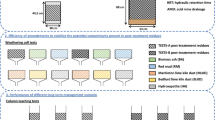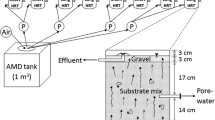Abstract
Economical remediation of acid rock drainage (ARD) at secluded high-altitude western ore mines is difficult given the current treatment technology. Several passive-engineered systems that are based on wetland technology were tested in the laboratory with three western ore mine ARDs (Co, Cu and Fe mines) and with a copper leachate effluent. These systems used well-weathered lodgepole pine sawdust as the sole carbon source and mud from a pond at one of the mine sites as the source of sulfate-reducing bacteria (SRB). Simple one-pass flow-through systems removed 44% to 99% of the various heavy metals from the Co and Cu mine ARDs and increased the pHfrom 3 to 7 after 28 days of SRB acclimation with a five-day residence time. Carbohydrate utilization rates were generally low, except for one 437-day run, which consumed 25%, 30% and 21% of the cellulose, hemicellulose and lignin, respectively. Initial pH, amounts of toxic heavy metals and the degree of pre de gradation of the sawdust were found to significantly affect both remediation potential and acclimation time. Engineered SRB systems, alone or in combination with other passive technologies, offer promise for the economical remediation of western US ore mine ARDs.
Similar content being viewed by others
References
Ackman, T.E., 1982, “Sludge Disposal from Acid Mine Drainage Treatment,” US Bureau of Mines Report of Investigations 8672.
Atlas, R.M., and Bartha, R., 1987, In Microbial Ecology: Fundamentals and Applications, 2nd Ed., Benjamin/Cummings Publishing Co., Inc., Menlo Park, CA.
Béchard, G., Rajan, S., Salley, J., and McCready, R.G.L., 1989, “Neutralization of acid mine drainage using microbial processes,” Proceedings of the 1989 Annual General Meeting of BIOMINET, Laval, Quebec, Canadian Government Publishing Centre, Ottawa, pp. 62–73.
Boominathan, K., and Reddy, C.A., 1992, “Fungal Degradation of lignin: Biotechnological applications,” In Handbook of Applied Mycology, Vol. 4: Fungal Biotechnology, D.K. Arora, R.P. Elander and K.G. Mukerji, Eds., Marcel Dekker Inc., New York, Chapt. 25, pp. 763–822.
Cowling, E.B., and Kirk, T.K., 1976, “Properties of cellulose and lignocellulosic materials as substrates for enzymatic conversion processes,” Biotechnol. Bioeng. Symp., pp. 95–123.
Dietz, J.M., Watts, R.G., and Stidinger, D.M., 1994, “Evaluation of acidic mine drainage treatment in constructed wetland systems,” US Bureau of Mines Special Publication SP 06A-94, Mine Drainage, Paper presented at the International Land Reclamation and Mine Drainage Conference and the Third International Conference on the Abatement of Acidic Drainage, Pittsburgh, PA. 1, pp. 70–79.
Dvorak, D.H., Hedin, R.S., Edenborn, H.M., and Gustafson, S.L, 1991, “Treatment of metal-contaminated water using bacterial sulfate reduction: Results from pilot-scale reactors,” Proceedings of the Second International Conference on the Abatement of Acidic Drainage, Montreal, 1, pp. 301–314.
Emerick, J.C., and Howard, E.A., 1988, “Using wetlands for the control of western acid mine drainage,” Paper presented at the SME Annual Meeting, Phoenix, AZ, Preprint No. 88–173.
Gusek, J.J., 1995, “Passive-treatment of acid rock drainage: What is the potential bottom line?” Mining Engineering. Vol. 47, No. 3, pp. 250–253.
Hellier, W.W., Jr., 1989, “Constructed wetlands in Pennsylvania: An overview,” In Biohydrometallurgy 1989, Proceedings of the International Symposium on Biohydrometallurgy, Jackson Hole, WY, J. Salley, R.G.L. McCready and P.L. Wichlacz, eds., CANMET SP89-10, Energy, Mines, and Resources Canada, pp. 599–611.
Hellier, W.W., Giovannitti, E.F., and Slack, P.T., 1994, “Best professional judgment analysis for constructed wetlands as a best available technology for the treatment of post-mining groundwater seeps,” Bureau of Mines Special Publication SP 06A-94, Mine Drainage, Paper presented at the International Land Reclamation and Mine Drainage Conference and at the Third International Conference on the Abatement of Acidic Drainage, Pittsburgh, PA. 1, pp. 60–69.
Hendricks, A.C., 1991, “The use of an artificial wetland to treat acid mine drainage,” Proceedings of the Second International Conference on the Abatement of Acidic Drainage, Montreal, 2, pp. 549–558.
Howard, E.A., Emerick, J.C., and Wildeman, T.R., 1989, “Design and construction of a research site for passive mine drainage treatment in Idaho Springs, Colorado,” In Constructed Wetlands for Wastewater Treatment: Municipal, Industrial, and Agricultural,” D.A. Hammer, ed., Lewis Publishers, Chelsea, MI.
Kalin, M., Fyson, A., and Smith, M.P., 1993, “ARUM — Acid reduction using microbiology,” In Biohydrometallurgical Technologies, A.E. Torma, M.L. Apel and C.L. Brierley, eds., The Minerals, Metals and Materials Society, pp. 319–328.
Kleinmann, R.L.P., Hedin, R.S., and Edenborn, H.M., 1991, “Biological treatment of mine water — An overview,” Proceedings of the Second International Conference on the Abatement of Acidic Drainage, Montreal, 4, pp. 27–42.
Kuyucak, N., Sheremata, T.W., and Wheeland, K.G., 1991, “Evaluation of improved lime neutralization processes. Part 3: Interpretation of properties of lime sludge generated by different processes,” Proceedings of the Second International Conference on the Abatement of Acidic Drainage, Montreal, 2, p. 31.
Kuyucak, N., Lyew, D., St-Germain, P., and Wheeland, K.G., 1991, “In situ bacterial treatment of AMD in open pits,” Proceedings of the Second International Conference on the Abatement of Acidic Drainage, Montreal, 1, pp. 335–353.
MacDonald, R.J.C., Kondos, P.D., Crevier, S., Rubinsky, P., and Wasselauf, M., 1989, “Generation of and disposal options for Canadian Mineral Industry effluent treatment sludges,” In Tailings and Effluent Management, Proceedings of the International Symposium on Tailings and Effluent Management, Halifax, pp. 139–157.
Noah, K.S., Sayer, R.L., and Thompson, D.N., 1988, “Modular Bioreactor For The Remediation Of Liquid Streams and Methods For Using The Same,” US Patent 5,772,887.
Postgate, J.R., 1984, The Sulphate-Reducing Bacteria, Second Ed., Cambridge University Press, Cambridge.
Rose, A.W., Stalker, J., and Michaud, L., 1998, “Remediation of acid mine drainage within strip mine spoil by sulfate reduction using waste organic matter,” In: Proceedings, 1996 American Society for Surface Mining and Reclamation, May 18–23, 1996, Knoxville, TN, pp. 321–335.
Saeman, J.F., Bubl, J.L., Harris, E.E., 1945, “Quantitative saccharification of wood and cellulose,” Ind. Eng. Chem., 17, p. 35.
Singer, P.C., and Stumm, W., 1970, “Acidic mine drainage: The rate-determining step,” Science, 167, pp. 1121–1123.
Siwik, R.S., and Payant, S., 1989, “Sizing of clarifiers and thickeners for lime neutralization plants,” In Tailings and Effluent Management, Proceedings of the International Symposium on Tailings and Effluent Management, Halifax, pp. 159–171.
Skousen, J., 1997, “Overview of passive systems for treating acid mine drainage,” Green Lands, Vol. 27, No. 4, pp. 34–43.
Thompson, D.N., Chen, H.-C., and Grethlein, H.E., 1992, “Comparison of pretreatment methods on the basis of available surface area,” Bioresource Technol., 39, pp. 155–163.
Wakao, N., Takahashi, T., Sakurai, Y., and Shiota, H., 1979, “A treatment of acid mine water using sulfate-reducing bacteria,” J. Ferment. Technol., Vol. 57, No. 5, pp. 445–452.
Wildeman, T., Brodie, G., and Gusek, J., 1993, Wetland Design for Mining Operations, T. Wildeman, ed., BiTech Publishers Ltd. Richmond, B.C., Canada. Chapters 12–16.
Wildeman, T. R., Gusek, J. J., Cevaal, J., Whiting, K., and Scheuring, J., 1995, “Bio treatment of acid rock drainage at a gold-mining operation,” In: Bioremediation of Inorganics, R.E. Hinchee, J.L. Means, and D.R. Burris, eds., Battelle Press, Columbus OH, pp. 141–148.
Author information
Authors and Affiliations
Additional information
Nonmeeting paper number 99–313. Oiscussion of this peer-reviewed and approved paper is invited and must be submitted to SME prior to Nov. 30, 2000.
Rights and permissions
About this article
Cite this article
Thompson, D.N., Sayer, R.L. & Noah, K.S. Sawdust-supported passive bioremediation of western United States acid rock drainage in engineered wetland systems. Mining, Metallurgy & Exploration 17, 96–104 (2000). https://doi.org/10.1007/BF03402835
Received:
Accepted:
Published:
Issue Date:
DOI: https://doi.org/10.1007/BF03402835




